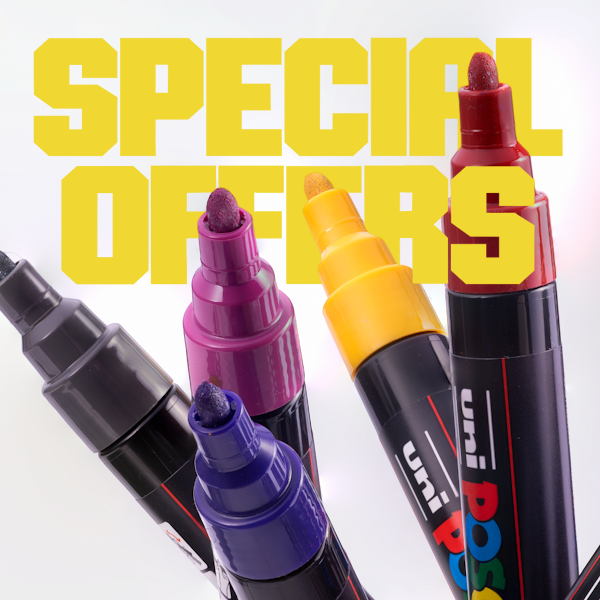At Cowling & Wilcox, our range of oil paints includes those of the best quality from leading art brands such as Winsor & Newton, Daler-Rowney and Michael Harding. We provide starter sets and professional oil paint sets for artists, alongside individual oil paints; so you can get the complete range or just individual colours you need to restock in your studio. We stock some of the best oil paints available, with a variety of oils ideal for experts and beginners, and everywhere in between. Browse our extensive range of oil paint tubes, sticks and bars before you get started on your next masterpiece!
We also recommend exploring our Mediums & Varnishes to pick up all the supplies you’ll need to finish your next masterpiece. You can also browse our range of oil painting brushes to find the perfect tool.
Looking for inspiration for painting with oils? Check out our blog with everything you need to know about Mixing Oil Paints, or our other blog which teaches you all about Painting With Oil Mediums.
What is oil paint?
Oil paint is a slow-drying medium composed of particles of pigment that are mixed with a drying oil, such as linseed oil. Oil paints are renowned for their flexible, viscous and glossy characteristics, as well as the range of colours that they offer.
The modern form of oil paint that we use today was developed during the 15th Century by a Belgian artist named Jack van Eyck. Oil paints were a key feature in artwork created during the Renaissance, which captured realistic and intense images.
How do you use oil paints?
Oil paints have a thicker consistency than other types of paint which can create stunning textures in your paintings. When using oil paints, we recommend using a stiff brush, preferably made from hog hair, as firm bristles will make it easier to control the viscous colour.
Before putting brush to canvas, tubes of oil paint need to be squeezed onto a palette and mixed with a palette knife to make different colours. Because of this, oil paints are known to be the most versatile medium. You can add solvents during this stage to thin your paints, making them last longer. Palette knives, such as this multipack from RGM, can also be used to apply paint to canvas to create interesting textures.
One thing to really consider is the notoriously long drying time of oil paints. This means that you can go on painting for hours with one layer of paint, however building up your composition will take time. You can use varnishes and mediums to manipulate drying times but we also suggest painting in thin layers so that they can be built upon. The thicker the paint, the longer it will take to dry. When all layers are dry, it is recommended to add a varnish to your canvas to give it a nice sheen and make your painting last.
How long does oil paint take to dry?
Oil paint is well known for being slow drying when compared to other types of paints like watercolours, acrylics and gouache. However, there’s no simple figure one can give as there is no fixed time for how long it takes oil paints to dry.
The time it takes oil paint to dry will depend on a variety of factors, including the room temperature, the thickness of the paint and the surface on which you’re painting. Canvas, vellum and wood all affect the amount of time it will take for your oil paint to dry.
The slow drying time of oil paint is part of its charm, it allows greater flexibility for blending, gives artists longer to work on specific areas of the painting and offers the time to rectify any mistakes if necessary.
Most people use different varnishes and mediums when painting with oil paints. These can all have an effect on the drying time of your oils, and it’s worth noting that those which will most likely help to speed up the drying process are Winsor and Newton's Liquin Original and Liquin Fine Detail. A warm, well-ventililated space will also encourage your oil painting to dry faster. Visit our blogs for more tips on how to paint like a professional with oil mediums.
How do you clean an oil painting?
It is natural for oil paintings to get dusty and a little faded over time hanging or sitting around the house. The first thing to know is not to clean your paintings too much - the more you clean them, the higher the risk of flaking or peeling away at the layers on the canvas. New paintings also should not be cleaned as the top layer of paint may not be fully dry and sealed. It can take years for oil paintings to be completely dry.
How you clean an oil painting and what materials you use will depend on the condition of the painting itself. Oil paints can sometimes become cracked or flake with age, in which case it can be dangerous to clean yourself without damaging further. However, you may only need to dry-clean it, which simply requires the use of a very soft brush. Taking the painting in stages, carefully remove dust and grime from the surface of the canvas. It is important to take one's time with this as to not cause any more long-lasting damage to the canvas.
You can also use small amounts of water to clean the surface of the oils, also using a soft haired brush. Remember to test the surface with a small amount to ensure the water wont remove any paint. Then use long, smooth, careful strokes of the brush with a light dusting of water to clear the surface. If you want to, you can also use a specialised oil-painting cleaner, such as C.R.P. Picture Cleaner, to clean, revive and preserve your painting.
What are the best surfaces for oil painting?
The most popular surface for oil painting tends to be canvas due to its affordability and lightweight properties, which make it easy to transport. Many canvases are primed and ready to use with oil paints immediately, however, some canvas options will need to be primed with a medium such as gesso prior to use. This will ensure that the oil paints do not damage the surface of the canvas and that the paint can adhere to the surface suitably.
You can also use metal, plastic paper and wood surfaces once you become more confident with this fascinating medium.
What are the best oil paints?
There are a lot of factors to consider when choosing which oil paint is best for you: cost, texture, and pigment to name just a few. Below are some of the great oil paint brands we stock here at Cowling & Wilcox:
-
Winsor & Newton: With 5 oil paint ranges for every purpose, Winsor & Newton can be found in just about every art shop. Their Winton Oil Colour range offers great colour pigment and texture for an affordable price, great if you’re just starting out in the world of oil paints.
-
Daler-Rowney: Traditionally crafted Daler-Rowney Georgian oils are another affordable option for students or beginners. Their brilliant colour pigments are consistent from wet to dry and require very little medium, making them an easy choice for acrylic users.
-
Schmincke: Another quality paint for an affordable price, Schmincke lends itself easily to brushes or knives. It’s smooth consistency allows for easy mixing and blending and is great for those using large quantities of paint.
-
Michael Harding: This is a great choice if colour pigment is your highest priority. While the price may be slightly higher than other options, the investment in Michael Harding oils is worth it to see your paint go further without any colour fading from the canvas. Check out our blog about the history and benefits to using Michael Harding paints.
-
Bob Ross: The unique, stiffer consistency of Bob Ross paints lend themselves perfectly for his iconic wet-on-wet painting technique. The selection packs also make for a great starter for new oil-painters.




















